Intel Architecture Day 2021: Alder Lake, Golden Cove, and Gracemont Detailed
by Dr. Ian Cutress & Andrei Frumusanu on August 19, 2021 9:00 AM EST
This week Intel held its annual Architecture Day event for select press and partners. As with previous iterations, the company disclosed details about its next generation architectures set to come to the market over the next twelve months. Intel has promised the release of its next-generation consumer and mobile processor family, Alder Lake, to come by the end of the year and today the company is sharing a good number of details about the holistic design of the chips as well as some good detail about the microarchitectures that form this hybrid design: Golden Cove and Gracemont. Here is our analysis of Intel’s disclosure.
Alder Lake: Intel 12th Gen Core
As mentioned in previous announcements, Intel will launch its Alder Lake family of processors into both desktop and mobile platforms under the name of Intel’s 12th Gen Core Processors with Hybrid Technology later this year. This is Intel’s second generation hybrid architecture built on Intel 7 process node technology. The hybrid design follows Intel Lakefield designs for small notebooks launched last year. The nature of a hybrid design in Intel nomenclature involves having a series of high ‘Performance’ cores paired with a number of high ‘Efficiency’ cores. Intel has simplified this into P-core and E-core terminology.
For Alder Lake, the processor designs feature Performance cores based on a new Golden Cove microarchitecture, and Efficiency cores based on a new Gracemont architecture. We will cover both over the course of this article, however the idea is that the P-core is preferential for single threaded tasks that require low latency, and the E-core is better in power limited or multi-threaded scenarios. Each Alder Lake SoC will physically contain both, however Intel has not yet disclosed the end-user product configurations.
Each of the P-cores has the potential to offer multithreading, whereas the E-cores are one thread per core. This means there will be three physical designs based on Alder Lake:
- 8 P-core + 8 E-core (8C8c/24T) for desktop on a new LGA1700 socket
- 6 P-core + 8 E-core (6C8c/20T) for mobile UP3 designs
- 2 P-core + 8 E-core (2C8c/12T) for mobile UP4 designs
Intel typically highlights UP4 mobile designs for very low power installs, down to 9 W, whereas UP3 can cover anything from 12 W to 35 W (or perhaps higher), but when asked about the power budgets for these processors, Intel stated that more detail will follow when product announcements are made. Intel did confirm that the highest client power, presumably on the desktop processor, will be 125 W.
Highlighted in our discussions is how modular Intel has made Alder Lake. From a range of base component options, the company mixed and matched what it felt were the best combination of parts for each market.
Here it shows that four E-cores takes up the same physical space as one P-core, but also that the desktop hardware will at most have 32 EUs (Execution Units) for Xe-LP graphics (same as the previous generation), while both of the mobile processors will offer 96 physical EUs that may be disabled down based on the specific line item in the product stack.
All three processors will feature Intel’s next generation Gaussian Neural Accelerator (GNA 3.0) for minor low power AI tasks, a display engine, and some level of PCIe, however the desktop processor will have more. Only the mobile processors will get an Image Processing Unit (IPU), and Thunderbolt 4 (TBT), and here the big UP3 mobile processor gets four ports of Thunderbolt whereas the smaller UP4 will only get two. The desktop processor will not have any native Thunderbolt connectivity.
A bit more info on the Desktop Processor IO and Interconnect
We’ll cover a bit more detail about the core designs later in this article, but Intel did showcase some of the information on the desktop processor. It confirmed explicitly that there would be 16 total cores and 24 threads, with up to 30 MB of non-inclusive last level/L3 cache.
In contrast to previous iterations of Intel’s processors, the desktop processor will support all modern standards: DDR5 at 4800 MT/s, DDR4-3200, LPDDR5-5200, and LPDDR4X-4266. Alongside this the processor will enable dynamic voltage-frequency scaling (aka turbo) and offer enhanced overclocking support. What exactly that last element means we’re unclear of at this point.
Intel confirmed that there will not be separate core designs with different memory support – all desktop processors will have a memory controller that can do all four standards. What this means is that we may see motherboards with built-in LPDDR5 or LPDDR4X rather than memory slots if a vendor wants to use LP memory, mostly likely in integrated small form factor designs but I wouldn’t put it past someone like ASRock to offer a mini-ITX board with built in LPDDR5. It was not disclosed what memory architectures the mobile processors will support, although we do expect almost identical support.
On the PCIe side of things, Alder Lake’s desktop processor will be supporting 20 lanes of PCIe, and this is split between PCIe 4.0 and PCIe 5.0.
The desktop processor will have sixteen lanes of PCIe 5.0, which we expect to be split as x16 for graphics or as x8 for graphics and x4/x4 for storage. This will enable a full 64 GB/s bandwidth. Above and beyond this are another four PCIe 4.0 lanes for more storage. As PCIe 5.0 NVMe drives come to market, users may have to decide if they want the full PCIe 5.0 to the discrete graphics card or not
Intel also let it be known that the top chipset for Alder Lake on desktop now supports 12 lanes of PCIe 4.0 and 16 lanes of PCIe 3.0. This will allow for additional PCIe 4.0 devices to use the chipset, reducing the number of lanes needed for items like 10 gigabit Ethernet controllers or anything a bit spicier. If you ever thought your RGB controller could use more bandwidth, Intel is only happy to provide.
Intel did not disclose the bandwidth connectivity between the CPU and the chipset, though we believe this to be at least PCIe 4.0 x4 equivalent, if not higher.
The Alder Lake processor retains the dual-bandwidth ring we saw implemented in Tiger Lake, enabling 1000 GB/s of bandwidth. We learned from asking Intel in our Q&A that this ring is fully enabled regardless of whether the P-cores or E-cores are being used – Intel can disable one of the two rings when less bandwidth is needed, which would save power, however based on previous testing this single ring could end up drawing substantial power compared to the E-cores in low power operation. (This may be true in the mobile processors as well, which would have knock on effects for mobile battery life.)
The 64 GB/s of IO fabric is in line with the PCIe 5.0 x16 numbers we saw above, however the 204 GB/s of memory fabric bandwidth is a confusing number. Alder Lake features a 128-bit memory bus, which allows for 4x 32-bit DDR5 channels (DDR5 has two 32-bit channels per module, so 2 modules still), however in order to reach 204 GB/s in that configuration requires DDR5-12750; Intel has rated the processor only at DDR5-4800, less than half that, so it is unclear where this 204 GB/s number comes from. For perspective, Intel’s Ice Lake does 204.8 GB/s, and that’s a high-power server platform with 8 channels of DDR4-3200.
This final slide mentions TB4 and Wi-Fi 6E, however as with previous desktop processors, these are derived from controllers attached to the chipset, and not in the silicon itself. The mobile processors will have TBT integrated, but the desktop processor does not.
This slide also mentions Intel Thread Director, which we want to address on the next page before we get to the microarchitecture analysis.


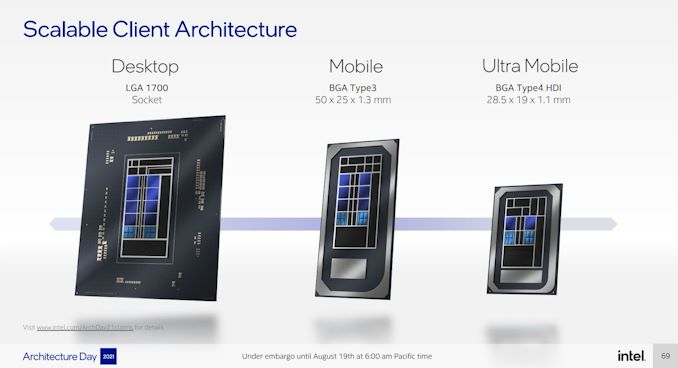

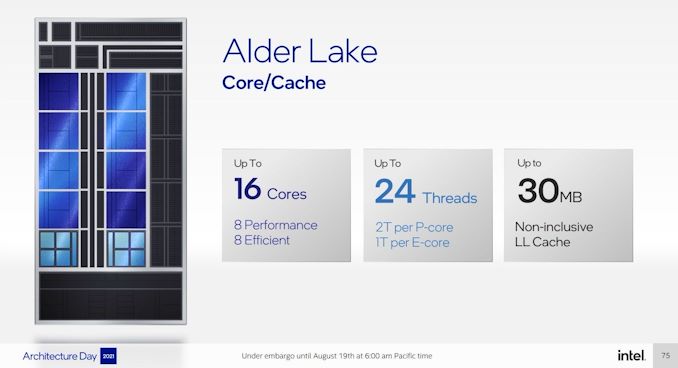
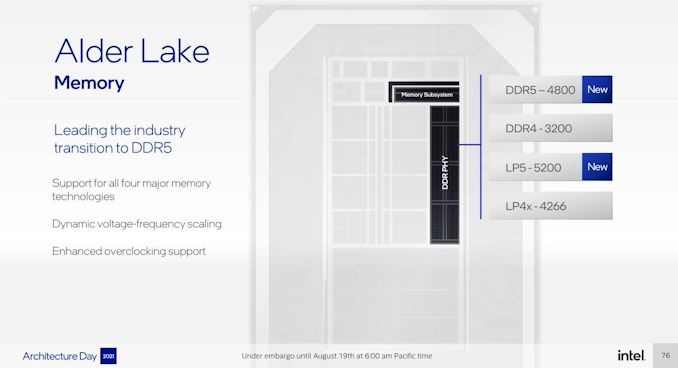
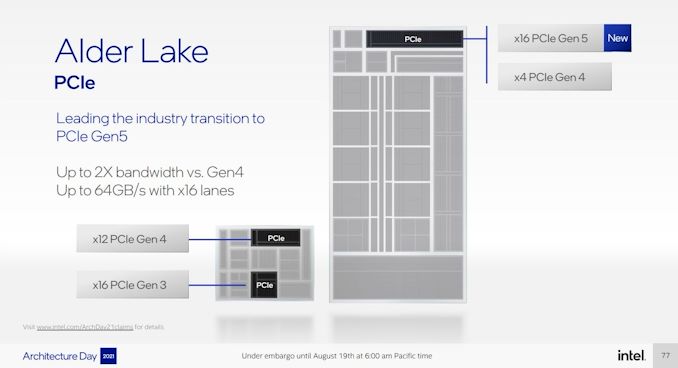
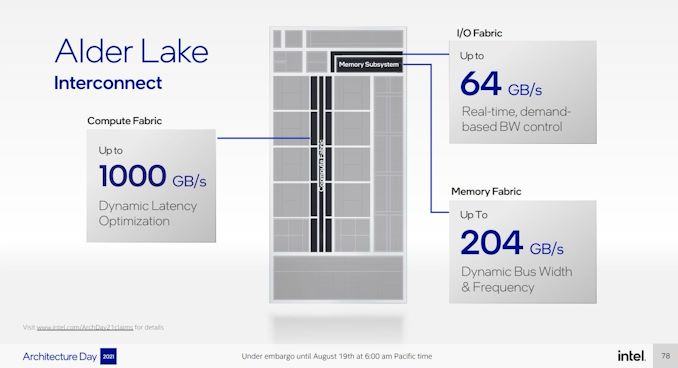
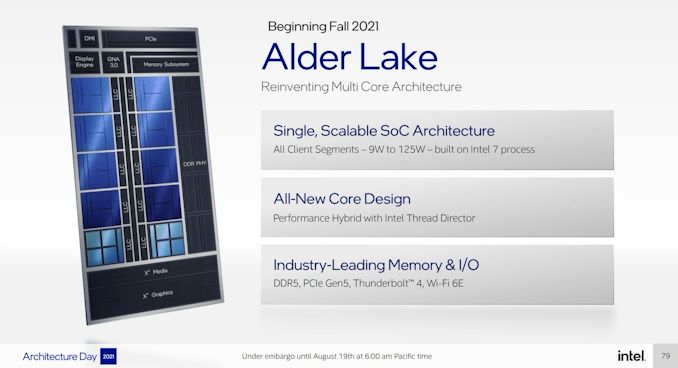








223 Comments
View All Comments
TristanSDX - Thursday, August 19, 2021 - link
"decreasing the manufacturing cost for Alder Lake, by using all the defect chips and reserving the good ones for Sapphire Rapids."Alder Lake and Shapire Rapids are two totally diffrerent chips
mode_13h - Thursday, August 19, 2021 - link
> Designed as its third generation of vector instructionsDepends on how you're counting. First is definitely MMX. That was extended in a few subsequent CPUs, but they didn't call those extensions MMX2 or anything. MMX was strictly integer, however, and total vector width was 64 bits. MMX had the annoying feature of reusing the FPU registers, which complicated mixing it with x87 code and basically requiring a state reset, when going from MMX -> x87 code.
Then, SSE came along and added single-precision floating-point. It also added a distinct set of vector registers, which were 128 bits. Finally, it included scalar single-precision arithmetic operations, beginning the era of x87's obsolescence.
SSE2 followed with double-precision and integer operations, making MMX obsolete and further replacing x87 functionality.
SSE3, the wondefully-named SSSE3, and a couple rounds of SSE4 came along, but all were basically just rounds of various additions to flesh out what SSE/SSE2 introduced.
Then, AVX was introduced as something of a replacement for SSE. AVX registers are 256 bits. Like SSE, AVX was initially just including single-precision floating-point support. And like SSE2, AVX2 added double-precision and integer operations.
Then, Xeon Phi (2nd gen) and Skylake-SP introduced the first variations on AVX-512 support. You can see what a mess AVX-512 is, here:
https://en.wikipedia.org/wiki/AVX-512#CPUs_with_AV...
Anyway, AVX-512 should be considered Intel's FOURTH family of vector computing instructions, in x86. I think the first time they dabbled with vector instructions was in the venerable i860 - a very cool, but also fairly problematic step in the history of computing.
> (AVX is 128-bit, AVX2 is 256-bit, AVX512 is 512-bit),
No, not at all. The register width for AVX and AVX2 is 256 bits, as I explained above.
However, even that is a slight simplification. AVX introduced some refinements in vector programming, such as a more compiler-friendly 3-operand format. Therefore, it was meant to subsume SSE usage, and included support for 128-bit operations. Similarly, AVX-512 introduced further refinements and the capability to use it on 128-bit and 256-bit operands.
For more, see: https://en.wikipedia.org/wiki/AVX-512#Encoding_and...
mode_13h - Thursday, August 19, 2021 - link
One more correction:> Some workloads can be vectorised – multiple bits of consecutive data all require
> the same operation, so you can pack them into a single register and perform it
> all at once with a single instruction.
Intel's vector instruction extensions aren't strictly SIMD. They include horizontal operations that you don't see in classical SIMD processors or most GPUs.
mode_13h - Thursday, August 19, 2021 - link
> One could argue that if the AVX-512 unit was removed from the desktop> cores that they would be a lot smaller
That's what I thought, but the area overhead it added to a Skylake-SP core was estimated at a mere 11%.
https://www.realworldtech.com/forum/?threadid=1932...
Of course, we can't yet know how much of Golden Cove it occupies, but still probably somewhere in that ballpark.
mode_13h - Thursday, August 19, 2021 - link
> Intel isn’t even supporting AVX-512 with a dual-issuePerhaps because AVX-512 doubled the number and size of vector registers. So, just the vector register file alone would grow 4x in size.
Schmide - Thursday, August 19, 2021 - link
64bit packed doubles are in avx as are some 64bit ints. AVX2 filled in a lot of gaps such as full vector operands and reorders. So as much as AVX2 finished off the 32 and 64bit ints (epi) functions. There was already a fair amount in avx.Schmide - Thursday, August 19, 2021 - link
not to be misleading. There were really no usable int functions in avx other than load and store.maroon1 - Thursday, August 19, 2021 - link
Gracemont beats skylake ???? Really ? I'm reading the article correctlySo these small cores are actually very powerful !!
vegemeister - Thursday, August 19, 2021 - link
The hypothetical 8% increase in peak performance seems like wishful thinking to me. The chart looks like "graphic design" marketing wank, not plotted data. I would only go by the printed numbers. That is, at an operating point that matches Skylake peak performance, Gracemont cores use less than 60% of Skylake's power, and if you ran Skylake at that same power, it would have less than 60% of Gracemont's performance.mode_13h - Thursday, August 19, 2021 - link
> I would only go by the printed numbers.Okay, so are those numbers you used hypothetical, or where did you see 60%?
Also, there's no fundamental reason why the ISO-power and ISO-performance deltas should match.